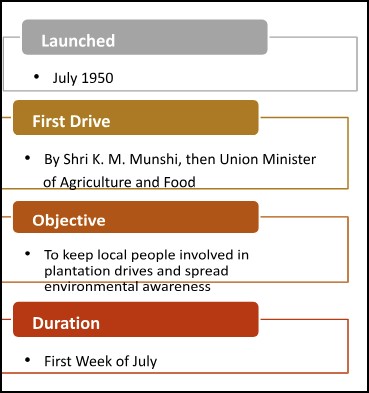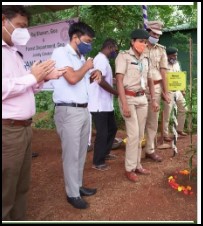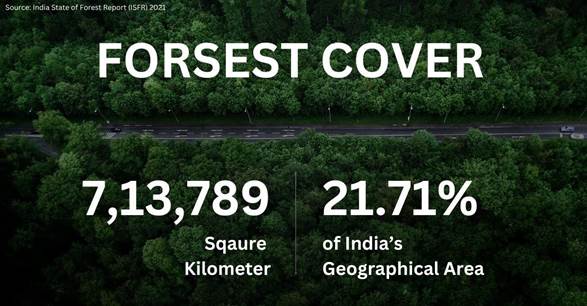Others
Van Mahotsav: A Commitment to Green India
Bridging Government Initiatives and Community Participation for a Greener Future
Posted On:
29 JUN 2024 9:32AM
In recent years, rapid urbanization has led to the widespread cutting down of trees to accommodate expanding infrastructure and housing needs. This relentless deforestation has resulted in significant environmental degradation, affecting air quality, climate stability, and biodiversity. As trees are felled to make way for urban development, the ecological balance is disrupted, underscoring the urgent need for reforestation and conservation efforts.
In this context, Van Mahotsav, meaning 'the festival of trees,' emerges as a beacon of hope and action. Launched in 1950 by Shri K. M. Munshi, the then Union Minister for Agriculture and Food, Van Mahotsav is an annual tree-planting festival celebrated across India from July 1st to July 7th. During this programme, saplings are planted in plantation drives conducted across the nation.


Background
The first Indian national tree plantation week was organized from 20 to 27 July 1947, by Shri M.S. Randhawa, Indian Historian, Civil Servant, and Botanist. The first event on 20 July 1947 was inaugurated with the planting of Bauhinia saplings by Shri Khurshid Ahmad Khan, Commissioner of Delhi in the morning. In the afternoon, another ceremony was held at Purana Qila led by the Vice President of the Interim Government, Shri Jawaharlal Nehru. Another day was called Ladies Day and involved planting at the Qutb Minar with participants including Lady Mountbatten. The tradition was continued and made into a national activity in 1950 by the Minister of Food and Agriculture Shri Kanaiyalal Maneklal Munshi. He moved it to the first week of July and renamed it Van Mahotsav in 1950, as the Monsoon in India begins in the first week of July. It is considered as the ideal time for planting saplings. Saplings that are planted during this time have more chances of survival.


Celebration of Van Mahotsav
‘Van Mahotsav’ has gained significant importance through the years. Millions of trees are planted during this program across India. This programme has raised awareness on conservation of trees and emphasizes the need for planting trees.
To celebrate ‘Van Mahotsav’, generally, native trees are planted owing to their ability to adapt to the local conditions better and thus have a higher survival rate. State Governments and civic bodies supply saplings to schools, colleges and academic institutions, NGOs and welfare organizations for planting trees during this week-long festival.
Additionally, programmes like screening of short films and documentaries, seminars and exhibitions, and painting and poster making competitions are organised to mark the occasion.
Other Tree Plantation Initiatives
The Ministry of Environment, Forest and Climate Change has taken various initiatives through programmes and schemes that encourage tree plantation including in the urban areas of the country.

Launched: 2024
Objective: To achieve green cover targets, achieve a green economy and adopt a sustainable lifestyle for combating the challenges of climate change; by planting a tree as a tribute to the mother

Launched: 2020
Objective: To create Nagar Van in Urban Areas, that promote urban forestry by involving local communities, NGOs, educational institutions, local bodies, etc

Launched: 2018
CAMPA: Compensatory Afforestation Fund Management and Planning Authority
Objective: To utilisze funds for compensating the loss of forest land and ecosystem services by raising of compensatory afforestation, improving quality of forests through assisted natural regeneration, enrichment of biodiversity, improvement of wildlife habitat, control of forest fire, forest protection and soil and water conservation measures

Launched: 2015-16
Objective: To protect, restore and enhance India’s diminishing forest cover and responding to climate change by a combination of adaptation and mitigation measures
Mission Goals:
-
To increase forest/tree cover to the extent of 5 million hectares (mha) and improve quality of forest/tree cover on another 5 mha of forest/non-forest lands;
-
To improve/enhance eco-system services like carbon sequestration and storage (in forests and other ecosystems), hydrological services and biodiversity; along with provisioning services like fuel, fodder, and timber and non-timber forest produces (NTFPs); and
-
To increase forest-based livelihood income of about 3 million households.

Objective: Ecological restoration of degraded forests and to develop the forest resources with peoples’ participation, with focus on improvement in livelihoods of the forest-fringe communities, especially the poor
Major Components: Afforestation under Seven plantation models, maintenance of previous years plantations and Ancillary Activities

Brief: India submitted its Intended Nationally Determined Contribution (NDC) to the United Nations Framework Convention on Climate Change (UNFCCC)
Objective: To create an additional carbon sink of 2.5 to 3 billion tonnes of CO2 equivalent through additional forest and tree cover by 2030 (stated as one of the objectives under India’s Intended Nationally Determined Contributions)
Achieving the Green Milestone
Due to the consistent and innovative efforts at both the national and grassroots levels, India has made significant strides in increasing its forest cover. According to the latest India State of Forest Report (ISFR) 2021, the total forest cover of the country is 7.13 lakh square kilometers, constituting 21.71% of India's geographical area. This marks an increase of 5,516 square kilometers in forest cover between ISFR 2017 and ISFR 2021.
Since 2018, the government has released Rs. 755.68 crores to seventeen states and one union territory for afforestation activities under the Green India Mission (GIM). Furthermore, 270 projects have been approved under the Nagar Van Yojana, with a total cost of Rs. 238.64 crores, aimed at promoting urban forestry. Additionally, since 2018, Rs. 55,394.16 crores have been disbursed to state and union territory forest departments under the Compensatory Afforestation Fund Management and Planning Authority (CAMPA) funds to further support afforestation and conservation efforts. These actions collectively highlight the nation's commitment to enhancing green cover and promoting sustainable environmental practices.*

To conclude, the tree plantation initiatives by the government affirm India's commitment to enhancing green cover and promoting sustainable lifestyles. By participating in Van Mahotsav and other tree plantation initiatives, we can collectively work towards a greener, healthier future. These efforts not only mitigate the effects of deforestation but also foster a culture of environmental responsibility, ensuring that future generations inherit a vibrant and resilient environment.
Santosh Kumar/Sarla Meena/Ritu Kataria/Apoorva Mahiwal
Click here to see in PDF
References
(Backgrounder ID: 151913)
आगंतुक पटल : 16610
Provide suggestions / comments